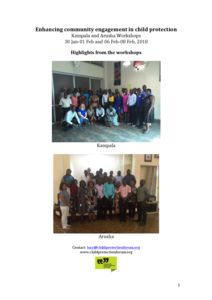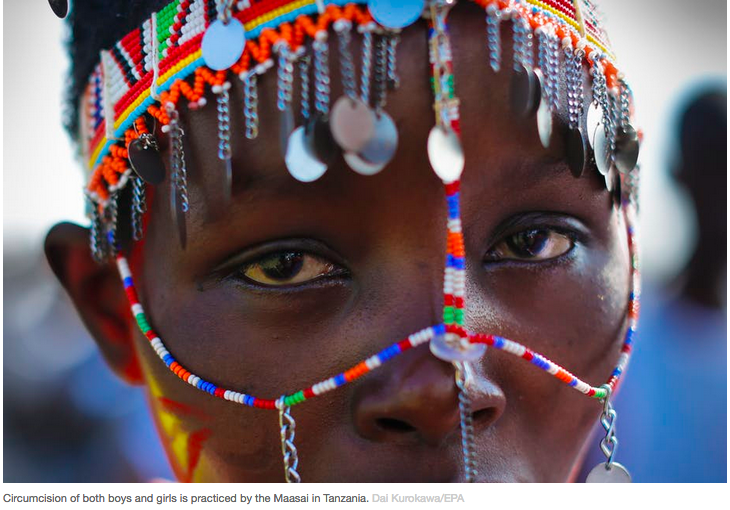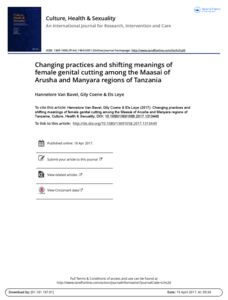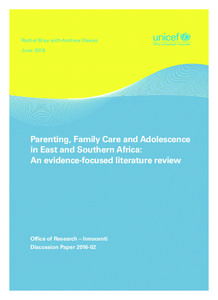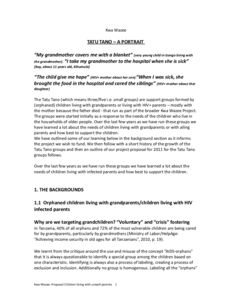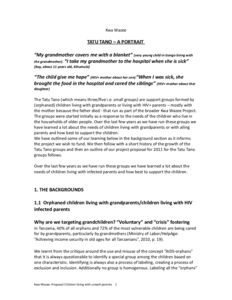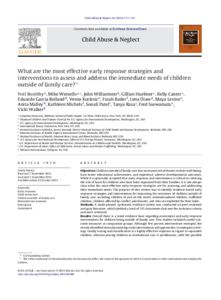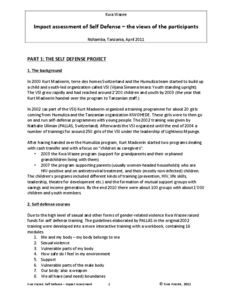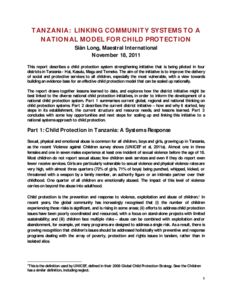Community action to reduce child marriage in Shinyanga, Tanzania. Summary report
Published: 2021
Author: Firelight Foundation
This report summarises achievements and learnings from an independent evaluation conducted by the AfriChild Centre of Excellence for the Study of the African Child, CBO grantee-partners’ reports, reports from community dialogues conducted by grantee-partners with their communities, consultant reports, and observations and reflections by Firelight staff.
Enhancing community engagement in child protection Kampala and Arusha Workshops – Highlights from the workshops
Published: 2018
Author: Community Child Protection Exchange for the Interagency Learning Initiative (ILI)
A themes-focused report back of the workshops held in Kampala and Arusha 30 Jan-01 Feb and 06 Feb-08 Feb, 2018. These workshops were designed to create the time and space for practitioners in Uganda and Tanzania to reflect deeply on aspects of their own organisation’s community-based child protection work, learn about each others’ work and other evidence and learning, and to think about how they might employ some different approaches moving forward.
How practices, and meaning, of genital cutting are changing in Tanzania
Published: 2018
Author: Hannelore Van Bavel a,b , Gily Coene c and Els Leye for "The Conversation"
Among the Maasai the circumcision of both boys and girls serves as a rite of passage from childhood to adulthood. Efforts to discourage the practice haven’t always resulted in fewer Maasai girls being cut. But new research shows that they have had an impact on the cultural meaning of the ceremonial rite of passage, as well as its context. Hannelore van Bavel, Els Leye and Gily Coene explain.
The Tatu Tano child-led organisation – Building child capacity and protective relationships through a child-led organisation, North-western Tanzania
Published: 2018
Author: Written by Glynis Clacherty, edited by Lucy Hillier, with contributions from Mike Wessells. Photographs by James Clacherty.
A case study collaboration between the Interagency Learning Initiative (ILI) on community-based child protection mechanisms, the Community Child Protection Exchange, and Kwa Wazee, Tanzania.
The story of the Vutamdogo Clubs, Mwanza, Tanzania. Youth clubs run livelihood projects and a literacy programme that provides protection for young children
Published: 2018
Author: Written by Glynis Clacherty, edited by Lucy Hillier, with contributions from Mike Wessells. Photographs by James Clacherty.
A case study collaboration between the Interagency Learning Initiative (ILI) on community-based child protection mechanisms, the Community Child Protection Exchange, and Tanzanian Home Economics Association (TAHEA).
Changing practices and shifting meanings of female genital cutting among the Maasai of Arusha and Manyara regions of Tanzania
Published: 2017
Author: Hannelore Van Bavel, Gily Coene & Els Leye
A study which looked at changing practices and shifting meanings of female genital cutting among the Maasai people in Tanzania. The findings suggest that an increasing social pressure to abandon female genital cutting has inspired thehiding of the practice, causing the actual cutting to become detached from its traditional ceremonial connotations. It advocates for more bottom approaches to support a contextually relevant approach to social change.
Parenting, Family Care and Adolescence in East and Southern Africa: An evidence-focused literature review
Published: 2016
Author: Rachel Bray and Andrew Dawes, United Nations Children’s Fund (UNICEF)
Based on an evidence-focused literature review, this paper examines existing knowledge on raising adolescents in East and Southern African countries, including Kenya, Malawi, Mozambique, South Africa, Tanzania and Zimbabwe.
Mbinu za kuimarisha mifumo ya ulinzi wa mtoto kuanzia chini kwenda juu mbinu na: Kuangazia watoto, familia na jamii
Published: 2015
Author: Mike Wessells
KiSwahili version of “Bottom-up approaches to strengthening child protection systems: Placing children, families, and communities at the center.” This article examines an alternative approach of community-driven, bottom-up work that enables non formal–formal collaboration and alignment, greater use of formal services, internally driven social change, and high levels of community ownership. From the journal: Child Abuse & Neglect
Tatu Tano – a portrait
Published: 2015
Author: Kurt Madoerin. Kwa Wazee
A background document on the Tatu Tano programme in Nshamba, Tanzania, Developed and implemented by Kwa Wazee.
Tatu Tano – a portrait
Published: 2015
Author: Kurt Madoerin/Kwa Wazee
An outline of the Tatu Tano programme and learning from 2015.
What are the most effective early response strategies and interventions to assess and address the immediate needs of children outside of family care?
Published: 2012
Author: Neil Boothby, Mike Wessells, John Williamson,, Gillian Huebner, Kelly Canter, Eduardo Garcia Rolland, Vesna Kutlesic, Farah Bader, Lena Diaw, Maya Levine, Anita Malley, Kathleen Michels, Sonali Patel, Tanya Rasa, Fred Ssewamala, Vicki Walker
A systematic review of evidence of effective early response strategies for children outside of family care.
Kwa Wazee’s Impact assessment of Self Defense – the views of the participants
Published: 2011
Author: Kwa Wazee
A 2011 evaluation of the Kwa Wazee girl’s self-defence training initiative in Nshamba, Tanzania.
Tanzania: Linking community systems to a national model of child protection
Published: 2011
Author: Sian Long, Maestral International
This report describes a child protection system strengthening initiative that was piloted in four districts in Tanzania. The aim of the initiative was to improve the delivery of social and protective services to all children, especially the most vulnerable, with a view towards building an evidence base for an effective child protection model that can be scaled up nationally.
Mobilising Children & Youth into their Own Child- & Youth-led Organisations
Published: 2008
Author: Kurt Madoerin. Published by REPSSI
Several decades of experience in working with vulnerable children across the planet had resulted in Kurt coming to believe that in the face of family, community and societal disintegration, the single most important supportive “intervention” that could be offered “to”, and more importantly “with” children and youth, might be the mobilisation of children and youth into their own child-led and youth-led organisations.
Impact Evaluation of the VSI (Vijana Simama Imara) organisation and the Rafiki Mdogo group of the HUMULIZA orphan project Nshamba, Tanzania
Published: 2005
Author: Glynis Clacherty and Professor David Donald
The aims of the Humuliza Project are to develop a practical instrument to enable
teachers and caregivers to support orphans psychologically and to develop the
orphans’ own capacity to cope with the loss of their caretakers.


